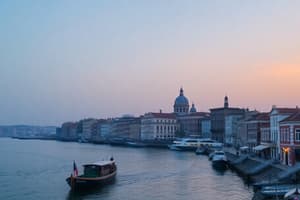Podcast
Questions and Answers
A travelogue is considered a piece of writing within the realm of creative ______, as it involves writing creatively using factual information encountered during travel.
A travelogue is considered a piece of writing within the realm of creative ______, as it involves writing creatively using factual information encountered during travel.
nonfiction
An effective travelogue uses vivid words and sensory details to describe sights, smells, tastes, sounds, and feelings, employing language both literally and ______ to immerse the reader.
An effective travelogue uses vivid words and sensory details to describe sights, smells, tastes, sounds, and feelings, employing language both literally and ______ to immerse the reader.
figuratively
When writing a travelogue, it's important not to simply repeat information commonly found in tourist guidebooks; instead, aim to provide original insights and ______ from your personal experiences.
When writing a travelogue, it's important not to simply repeat information commonly found in tourist guidebooks; instead, aim to provide original insights and ______ from your personal experiences.
observations
The best time to write a travelogue is immediately after returning home from your trip, as your ______ are still fresh and you can recall events clearly.
The best time to write a travelogue is immediately after returning home from your trip, as your ______ are still fresh and you can recall events clearly.
While creating a travelogue, you should try to convey the ______ of the place you visited, allowing readers to feel as though they are experiencing the location alongside you.
While creating a travelogue, you should try to convey the ______ of the place you visited, allowing readers to feel as though they are experiencing the location alongside you.
In addition to personal experiences, a good travelogue includes information that is useful for those who may want to visit the country you describe, providing practical ______ for potential travelers.
In addition to personal experiences, a good travelogue includes information that is useful for those who may want to visit the country you describe, providing practical ______ for potential travelers.
A well-written travelogue often ends with a reflection on a lesson learned, a personal ______, or a significant discovery made during the journey.
A well-written travelogue often ends with a reflection on a lesson learned, a personal ______, or a significant discovery made during the journey.
While documenting your travels, avoid taking excessive self-portraits with historical monuments, as the focus should be on the ______ and culture of the place you are visiting.
While documenting your travels, avoid taking excessive self-portraits with historical monuments, as the focus should be on the ______ and culture of the place you are visiting.
When crafting your narrative, it's important to develop your story either thematically or ______, ensuring that the travelogue maintains a sense of momentum and direction.
When crafting your narrative, it's important to develop your story either thematically or ______, ensuring that the travelogue maintains a sense of momentum and direction.
It is critical to always ______ and edit your travelogue, to make the writing more professional and easier for your readers to enjoy.
It is critical to always ______ and edit your travelogue, to make the writing more professional and easier for your readers to enjoy.
Flashcards
Travelogue
Travelogue
A piece of creative nonfiction writing about travel, often including personal experiences and observations.
Travelogue Content
Travelogue Content
Factual details about history, culture, geography, cuisine, people, and language presented with originality and sensory details.
Travelogue Definition
Travelogue Definition
A person’s account of a journey, including factual details and personal impressions supported by images.
Travelogue Steps
Travelogue Steps
Signup and view all the flashcards
Travelogue Topics
Travelogue Topics
Signup and view all the flashcards
Travelogue Structure
Travelogue Structure
Signup and view all the flashcards
Travelogue 'Do's'
Travelogue 'Do's'
Signup and view all the flashcards
Travelogue 'Don'ts'
Travelogue 'Don'ts'
Signup and view all the flashcards
Study Notes
- A travelogue is a type of creative nonfiction that involves writing about travel.
- It can be a written piece, a talk with film or slides, or a narrated motion picture.
- Travel essays can inform readers interested in travel or tourism as a hobby.
- A good travelogue includes facts about the history, culture, geography, cuisine, people, and language of a place.
- Facts in a travelogue should relate to the theme and should be presented originally.
- Scene-building and vivid descriptions using sensory details are essential.
- A travelogue can be a factual report or a personal narrative with images.
Steps for Writing a Travelogue
- Decide on the purpose of your travelogue.
- Take notes while traveling about observations, places, and people.
- Take many pictures.
- Review your recordings upon returning home.
- Create an outline for your travelogue.
- Write the full travelogue after completing the outline.
Common Travelogue Topics
- Local customs and traditions
- Cuisine
- Depictions of places of interest, local history, and culture
- Personal adventures
- Prices and transportation
- Entertainment
How to Start Writing
- Begin with a compelling lead.
- Develop your story thematically or chronologically.
- Conclude with a lesson, discovery, or personal transformation.
Do's
- Include personal experiences and practical information.
- Convey the atmosphere of the place.
- Provide historical and cultural background.
- Write immediately after returning home.
- Add humor.
- Proofread and edit your travelogue.
Don'ts
- Take pictures of yourself with monuments in the background.
- Repeat tourist guidebook information.
- Use stock photos from the internet.
- Judge or mock other countries' customs.
Studying That Suits You
Use AI to generate personalized quizzes and flashcards to suit your learning preferences.




